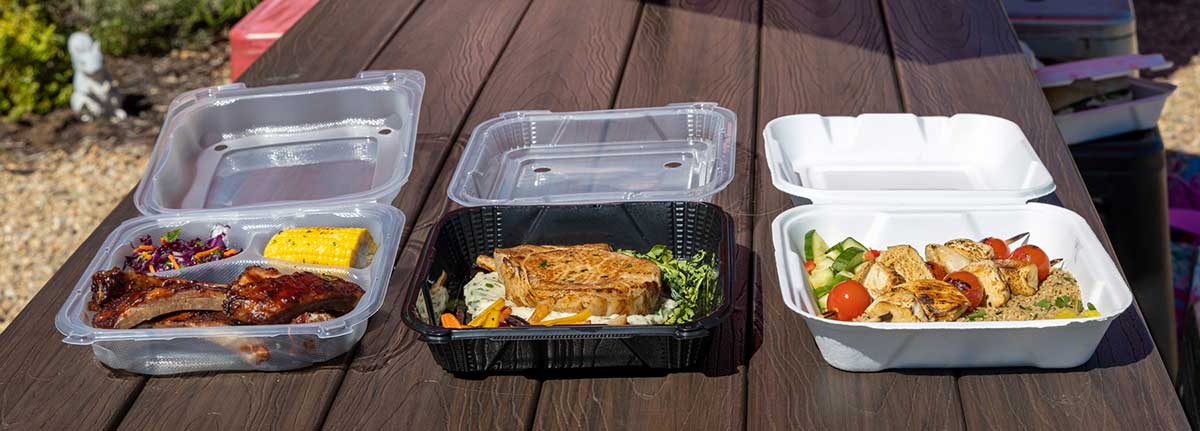
Are local laws dictating you use foam alternative food packaging at your restaurant? In the past few years, major metropolitan cities like New York, San Diego, Miami Beach, Seattle and Washington, DC have banned styrofoam packaging, also known as polystyrene, for environmental reasons.
While this has shaken up a lot of the ways restaurants traditionally thought about takeout and leftover containers, there are several key advantages foam alternative packaging can bring to customers, the environment, and your restaurant!
Whether you are in an area of the country where foam containers were recently banned, or you are considering switching your current foam packaging to foam alternative containers, learn about some of those benefits and the different foam alternative packaging options we offer below!
The Benefits of Foam Alternative Food Packaging
Thinking of making the switch from styrofoam packaging to foam alternative containers? Here are the benefits it can bring along with some alternative packaging options!
1. They May Be Biodegradable
Biodegradable, or compostable, refers to material that is capable of being broken down by bacteria and other natural processes in a reasonably short period of time. This compost can then be used as a conditioner to soil to help grow future plants! While polystyrene is not biodegradable, there are foam alternative materials, such as natural plant fiber, that are, which can make your food container 100% compostable.
Our Harvest Fiber container line is completely compostable, which means when placed into a professionally managed compost facility, Harvest Fiber items will turn into compost within 90 days!
2. Styrofoam Alternatives May Be Curbside Recyclable
One of the best ways to reduce excess waste in landfills is by recycling. Unlike styrofoam containers, foam alternative products can be made from materials that are curbside recyclable. That means less amount of waste in landfills from food packaging!
Our ProView™ Hinged Containers and Clover Hinged Containers are both made from polypropylene and do not contain foreign mineral fillers, which means they are recyclable in most communities.
3. They May Be Dishwasher Safe (And We Know Foam Packaging Is Not)
For customers who want to wash and reuse take out containers, having containers that are dishwasher safe is essential. Using foam alternative containers made from materials that can withstand the heat of dishwashers allows you to provide containers customers can conveniently wash and reuse.
Our ProView™ Hinged Containers and Clover Hinged Containers are both top rack dishwasher safe, so customers can wash and reuse again and again!
4. They May Be Microwave Safe
Leftover containers that are microwave safe provide an easy and convenient customer experience so customers can reheat leftovers right in the container. While styrofoam packaging is not meant for the microwave, foam alternative packaging can be made from materials that are microwave safe.
Our ProView™ Hinged Containers and Clover Hinged Containers are both microwave safe, so customers don’t have to dirty another dish when reheating leftovers!
5. They May Offer Superior Food Product Visualization
We’ve all heard the saying “You eat with your eyes first.” And by using clear tops as opposed to foam lids, you have the opportunity to do so! Foam alternative containers with clear lids allows customers to view the deliciousness of your food before they eat it!
Our ProView™ Hinged Containers showcase food on sleek black bases with clear lids. Whether it’s filled with restaurant leftovers or a grab-and-go meal, food can be viewed with restaurant quality presentation.
6. They May Be Made From Sustainable Materials
Sustainability is the key to ensuring the planet is not depleted of resources for future generations. By using styrofoam alternative containers, you can choose containers made from sustainable materials like bamboo, hemp, and plant fiber.
Our Harvest Fiber products are made using Bagasse (sugar cane fiber), an annually renewable resource, which means those resources can be restored naturally within one year. Likewise, our Harvest Choice Containers are made from paperboard material sources from SFI certified forests, which mean materials come from sustainably harvested forests.
7. Customers Are Asking For Them
Consumer demand drives change. There’s no question that our culture is increasingly becoming more eco-conscious. And as recent policy changes have shown, that has a profound impact on our lives right down to our restaurant takeout containers! More and more consumers are demanding that the restaurants they frequent utilize foam alternative packaging to match their lifestyles and views on environmental sustainability. Show customers you are listening by adopting foam alternative packaging.
8. It Could Save You Money (Possibly In More Than One Way)
One of the easiest ways to realize cost savings in the transition to eco-friendly food packaging is by avoiding potential fines and penalties imposed by local municipalities for the continued use of styrofoam packaging. By proactively making the switch to more sustainable alternatives, businesses can avoid the headaches that may arise from attempts to circumvent local food packaging laws. The potential legal consequences and associated costs can pose a significant burden on small, local businesses, making the transition to foam food packaging alternatives a prudent and fiscally responsible choice.
An increasing number of businesses embrace environmentally friendly practices. As this shift in market demand continues, it has the potential to drive down the overall cost of foam alternative food packaging over time. Simultaneously, the continued use of styrofoam containers may become more expensive due to potential regulatory surcharges or increased manufacturing costs associated with maintaining compliance with environmental standards. Not only does transitioning to foam alternatives align with sustainable practices, but it also positions businesses to benefit from potential long-term cost reductions as the market evolves.
Interested in Learning More About Our Foam Alternative Containers?
Whether by policy change or by choice, if you’re new to the world of foam alternative packaging for the food service industry, we’re here to help! Contact our sales team for more information on purchasing our popular food containers. Or take a moment to learn the factors to consider when buying foam alternative food packaging.
